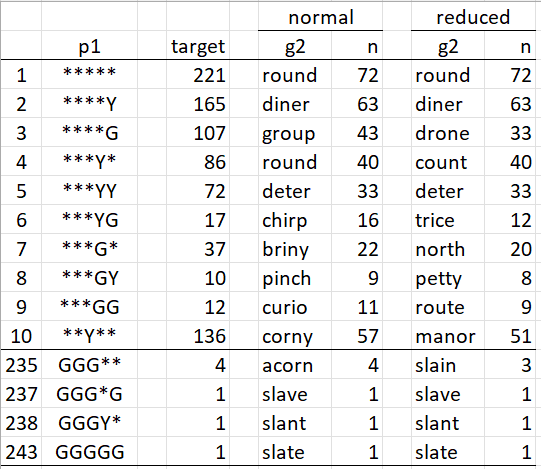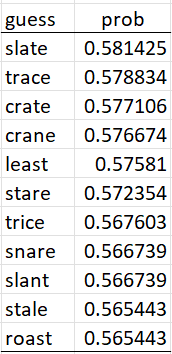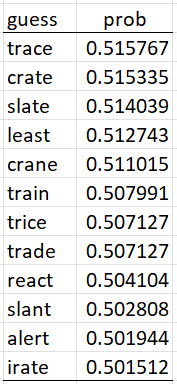Objective
On this webpage, we describe the strategy for optimizing the chances of guessing Wordle’s target word within 3 tries. We make the further restriction here that we can only make guesses from the 2,315-word Wordle dictionary. We relax this restriction in Best Guesses from Full Dictionary.
Probability of a win within three tries
Figure 1 shows the same information as Figure 3 of Best Two First Guesses. Only the first and last few rows of the table are displayed.
Figure 1 – Two rounds for “slate”
We see from the figure that if Wordle returns the pattern “*****” (i.e. no matches) after an initial guess of “slate”, there are 221 possible target words that fit this pattern. The sum of all the values in the count 1 column of Figure 1 is 2,315, as we would expect. Now the probability of a win within three tries can be calculated by
This is equivalent to
Note that the numerator in this fraction is the sum of the count 2 terms in Figure 1.
In a similar fashion, we see that the probability of guessing the target word in at most three tries starting with “slate”, restricting our second guess to a target that is consistent with the pattern returned by Wordle to the first guess is
Here we used the counts from the last column of Figure 1.
Best initial guess
Based on our analysis, “slate” is the best initial guess when our goal is to maximize the probability of guessing the target within three tries. We believe that the next best initial guesses are as shown in Figure 2.
Figure 2 – Best initial guesses
It turns out that “trace” is a slightly better choice than “slate”, with a 51.5767% probability of success, when we restrict our second guess to those words that are consistent with the first-guess pattern. We believe that the best initial guesses based on this restriction are shown in Figure 3.
Figure 3 – Best initial guesses based on a restricted second guess
Strategy for victory within three tries
Based on Figure 2, “slate” is the best initial guess. This means that it has the best chance of producing a win within 3 tries. The best second guess then depends on the pattern that Wordle returns after the first guess. The best second guesses are listed in Figure 3 of Best Two First Guesses.
For example, if Wordle produces the pattern “*GG**” after the initial guess, then your second guess should be “berry”. Your third guess depends on the pattern that Wordle returns after your second guess of “berry”, as shown in Figure 2 of Best Two First Guesses.
For each first-guess pattern and recommended second guess, we need a table of third guesses similar to that provided in Figure 2 of Best Two First Guesses. These tables are relatively easy to generate, but because there are so many of them, we will instead use the Real Statistics worksheet function Guesses3 (see Real Statistics Wordle Support).
Reference
New York Times (2022) Wordle
https://www.nytimes.com/games/wordle/



I’m sorry but what is the difference between the target dict and reduced list?
Hello Robert,
When I wrote this webpage, the target word, namely, the word you were trying to guess could only come from a 2,315-word Wordle dictionary. You could make guesses, however, from a larger list of 12,497 words.
This may have changed, but that was the situation then. This website provides the words in these two lists.
Charles
Charles how would this strategy work for game 1523
I used slate, it returns *GG***
So then I used prick, returns *****
Then it is not an obvious guess next?
Hi David,
Assuming the word list for Wordle hasn’t changed since I wrote the Wordle section of the website, the only valid target words are bland, gland, llama. If you guess bland, then either it is the target word or you will have enough information to choose between gland and llama on the next guess.
Charles
I didn’t understand a word of that. But I get wordle in three more times than not
Hi Christine,
If you win in three, then keep doing what you are doing.
Charles